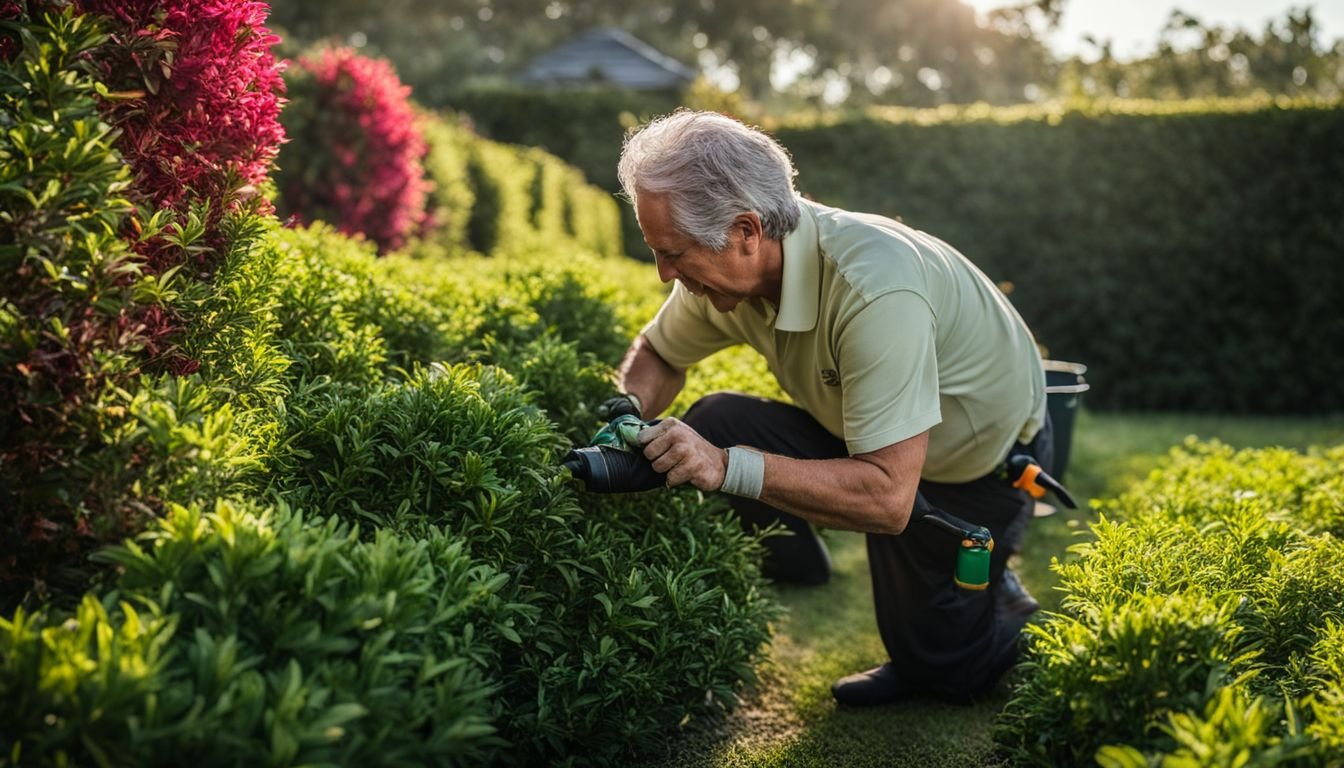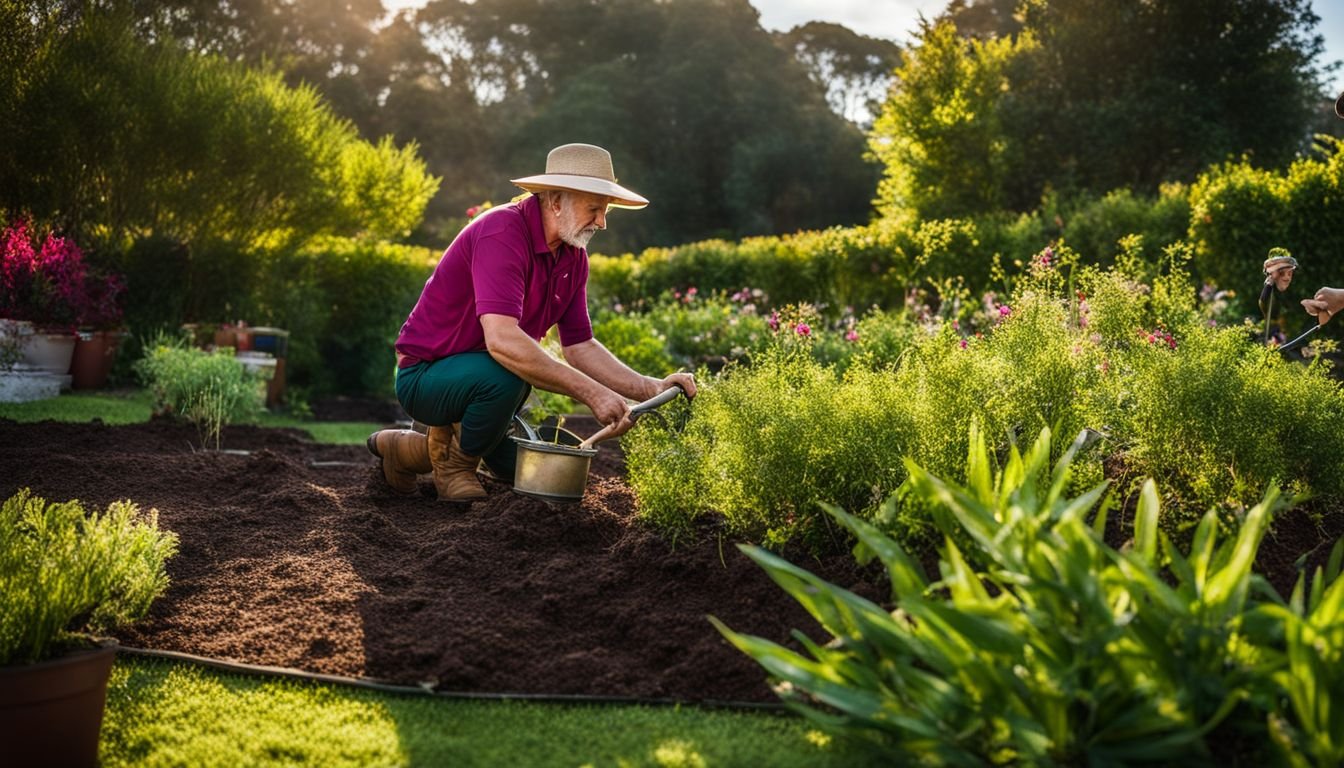Gardening down under comes with its fair share of challenges, but also loads of delight. If you’re on the hunt for the perfect hedge that not only offers privacy and splendour but also wafts a bit of nature’s fragrance around your backyard, well, you’re not alone.
It’s quite the task, sifting through all those options to land on the plant that ticks every box on your gardening wishlist.
Our own quest led us to stumble upon Murraya paniculata or as it’s fondly known, “orange jasmine” or “mock orange”. This beaut is famed for its bright scent bringing to mind orange blossoms at their peak.
But this evergreen shrub isn’t just a treat for the nose; it’s a trooper across various soil types – whether it be sandy, loamy or clayey – making it an ace choice no matter what your garden throws at it.
We’re here to walk you through how to bring this vibrant greenery into full flourish in Aussie gardens step by step. From picking out just the right type for your patch to ensuring your Murraya hedge thrives with minimal fuss.
Prepare yourself for a more lush landscape!
Key Takeaways
- Choose the right variety of Murraya for your garden, considering if you want a dense privacy screen or something that blooms often. There’s a type perfect for warm climates and well-drained soil.
- Prepare the planting area by choosing a sunny spot, enriching soil with organic matter, and ensuring good drainage to avoid waterlogging. Space plants correctly for a dense hedge.
- Prune your Murraya hedge in autumn to encourage thick growth and flowering. Use sharp tools for neat cuts and remove any dead or diseased branches first.
- Keep an eye out for pests like aphids or diseases such as leaf spot. Treat problems early with insecticidal soap or appropriate pesticides to keep your hedge healthy.
- Water newly planted hedges once or twice weekly depending on weather conditions, keeping soil consistently moist but not soaked encourages strong growth without root issues.
Selecting Your Murraya Hedge

Picking the right Murraya, or orange jessamine as some call it, starts with knowing what you want from your hedge. Do you need a dense barrier for privacy or something lovely to look at? Each variety of this plant serves a different purpose in your garden.
Some types offer lush growth perfect for a solid privacy screen, while others might bloom more often, adding beauty and fragrance. Selecting involves thinking about hedge spacing too; how close you plant them affects how quickly they’ll form a full hedge.
Remember to choose varieties that thrive in warm climates and well-drained soil to give your plants the best start.
Purpose of the Hedge
Creating a Murraya hedge serves more than one purpose in our gardens. For starters, we use these hedges as privacy screens. They grow tall and dense, stopping prying eyes from peeping into our yards.
This makes them perfect for surrounding patios or pools. Not to mention, they add a lush green look that beautifies any space.
Another key purpose of the Murraya hedge is to attract wildlife. With their bright red-orange berries, these plants become a haven for birds, butterflies, and bees. Such activity not only brings life to our garden but also helps with pollination of other plants around.
We plant not for today but for tomorrow.
Moving on, let’s explore which varieties of Murraya will suit your specific needs best.
Suitable Murraya Varieties
Finding the right Murraya variety for your garden can boost its appeal and functionality. We need to consider both our needs and the conditions in our garden.
- Murraya paniculata: This is a widely-loved choice for creating dense, privacy hedges due to its lush foliage and sweet-smelling flowers. It grows well in most Australian climates, offering a thick screen that thrives with regular pruning. The dark green leaves and white flower clusters also attract birds with their bright orange fruits.
- Dwarf Varieties: For those of us who prefer compact garden designs or decorative borders, dwarf varieties like “Min-a-min” are perfect. They maintain a manageable height, making them ideal for small spaces or as garden accents.
- Frost Tolerant Varieties: Certain areas in Australia experience frosty winters that can harm sensitive plants. Frost-resistant varieties of Murraya ensure our hedge remains vibrant and healthy year-round, even in cooler climates.
- For Botanical Craftspeople: If you’re into topiary or fancy shaping your greenery into artistic designs, select types with a dense growth habit like Murraya paniculata are ideal. Their robust growth allows for intricate shaping and provides a lush backdrop for other plants.
Each variety has its unique benefits, from attracting wildlife with fragrant blossoms and colourful fruits to fitting into sophisticated garden layouts with their dense foliage. We choose according to what matches our garden’s design dreams and practical needs, ensuring our Murraya hedge not only thrives but beautifies our space all year round.
How to Cultivate a Murraya Hedge

Growing a Murraya Hedge is all about getting the basics right. You need to pick the perfect spot and prepare your planting area with care.
First off, make sure you choose a location where your hedge will thrive – think plenty of sunlight and good airflow. Then, it’s time to get your hands dirty prepping the soil. Mix in loads of organic matter to feed those hungry roots and ensure excellent drainage to prevent water from pooling around them.
When you’re ready to plant, spacing is key. Place each shrub far enough apart so they have room to spread out but close enough for them to eventually join up and form that dense, lush barrier you’re after.
After planting, giving them a good drink helps settle everything into place.
From there on, it’s all about regular care – watering just right, feeding with nutrients like sulphate of ammonia for growth boosts, and keeping an eye out for unwanted visitors like aphids or mealybugs that might harm your hedge.
With these
Choosing the Location
Selecting the right spot in your garden for a Murraya hedge makes all the difference. You must pick a sunny area because these hedges thrive under the bright sky. A place that gets plenty of daylight suits them best, ensuring they grow dense and lush.
The health of your hedge begins with where you plant it, so favor spots that soak up lots of sun throughout the day.
“The secret to a vibrant Murraya hedge lies in its roots; choose well-lit sites for optimum growth.”
Consider soil types as well. Our hedges aren’t picky – they grow in loamy, sandy, or even clayey soils. Still, good drainage is key to prevent water from pooling around their roots.
Mixed with organic matter like compost can boost soil nutrition significantly, supporting a robust root system capable of resisting pests like aphids and diseases such as leaf spot.
Opting for an area with naturally fertile ground or improving your chosen site’s soil before planting will set the foundation for a thriving hedgerow.
Preparing the Soil
We begin with making sure the ground is ready for our Murraya hedge. The great news is, these plants are not fussy eaters and can grow in loamy, sandy, or clayey dirt types. First, we dig the area where we plan to plant.
This should be about twice as wide as the root ball of our plants. We must ensure good drainage because standing water can spell trouble for our Murrays.
Next up, enriching the soil plays a big part in giving our hedges a strong start. Mixing in well-rotted manure or compost helps add valuable micronutrients into the earth – think of it as a nutrient-packed meal for your plants.
For an extra boost during dry spells common to Australian climates, consider mulching after planting. Mulch keeps moisture within reach of roots and stops weeds from taking over.
Lastly, checking that everything lines up perfectly before putting down roots is key. Space each shrub about half a meter apart so when they grow up, they form one seamless green wall without overcrowding each other.
This spacing also allows air to circulate freely reducing risks of fungal diseases which thrive in cramped conditions.
Transplanting and Watering
Transplanting your Murraya hedge is an exciting step in creating your garden oasis. We tackle this task in autumn when the conditions suit the plants best. Let’s walk through the steps together to ensure a lush, thriving hedge.
- Pick a sunny location for your Murraya: Your chosen spot must bathe in sunlight for at least six hours daily. This exposure ensures your plants have enough light to grow strong and healthy.
- Prepare the ground with care: Use soil that drains well to prevent water from pooling around the roots. Mixing in some organic compost can improve soil quality, creating an ideal bed for your Murraya cuttings or saplings.
- Space out your plants correctly: When transplanting, give each plant enough room to spread its roots and grow without competition. A good rule of thumb is spacing them about 60-90 cm apart, depending on the variety.
- Dig holes for each plant: Make sure each pit is twice as wide as the root ball but just as deep. This extra space encourages roots to spread outward, anchoring your plant firmly and promoting growth.
- Position your Murraya in their new home: Carefully place each cutting or sapling in its hole, keeping it upright and making sure it’s planted at the same depth it was growing previously. Backfill with soil gently but firmly to remove air pockets.
- Water immediately after transplanting: Give each new plant a good soak right after planting to settle them into their new environment and provide essential moisture for root development.
- Establish a watering schedule: Newly transplanted hedges appreciate being watered once or twice weekly, depending on weather conditions like heat and wind that increase water need by affecting moisture levels in the soil. Keeping soil consistently moist (but not waterlogged) promotes healthy growth.
- Monitor soil moisture regularly: Stick a finger into the earth near your plants; if it feels dry an inch below the surface, it’s time to water again.
With these steps, we set our Murraya hedge up for success, looking forward to days filled with lush greenery and fragrant blooms filling our gardens.
Murraya Hedge Maintenance
Keeping your Murraya hedge in top shape means regular trimming and spotting troubles early. Use garden shears for a neat appearance and apply bug-killing soap if pests like whiteflies show up.
Pruning
Pruning our Murraya hedge helps it grow thick and dense. Autumn is the perfect season for this task, setting the stage for spring blossoms.
- Gear up with the right tools: Grab a sharp pair of secateurs or a hedge trimmer. These tools make clean cuts that help the plant heal faster.
- Start with dead or diseased branches: Cut these out first to keep your hedge healthy. Look closely and remove any parts that don’t look right.
- Shape your hedge: Trim the sides in a slight A-shape, narrower at the top. This shape lets sunlight reach the lower branches.
- Encourage new growth: Lightly prune the top and sides of your Murraya hedge regularly. This encourages denser foliage.
- Avoid deep cuts into old wood: Murraya hedges sprout from green wood better than from old, hard stems.
- Clean up after pruning: Gather all the cuttings and dispose of them properly to avoid pests and diseases.
- Check for pests like whiteflies or signs of diseases such as galls when you prune. If you spot any, treat your hedge with insecticidal soap or a suitable pesticide.
With patience and care, our Murraya hedge will become a lush, flowering barrier that ads beauty to our garden year-round.
Troubleshooting Common Problems
Taking care of a Murraya hedge means dealing with some challenges along the way. Our tips will help you keep your hedge healthy and beautiful.
- Yellow leaves often point to overwatering or lack of nutrients. Check the moisture in the soil before watering and add fertiliser if needed.
- Flowers not blooming could mean your plant is in too much shade. Move it to a sunnier spot if possible.
- An unkempt appearance calls for pruning. Cut back overgrown branches to encourage growth and maintain shape.
- Invasive growth outside the desired area requires regular trimming. Keep an eye on your hedge’s boundaries.
- Soil nematodes, small parasitic creatures, can hurt your hedge’s roots. Treat with organic pesticides and remove affected plants fast.
- Aphids, tiny bugs sucking on leaves, weaken your Murraya. Spray them off with water or use insecticidal soap.
- Bacterial infections show as leaf spots and decay. Prune away sick parts and dispose of them properly to stop the spread.
- Root and crown rot from too much water makes leaves yellow and drop off. Let the soil dry out before you water again.
With these pointers, we can handle most problems our Murraya hedges face in their cultivation journey.
Conclusion
Crafting a lush Murraya hedge in your Australian garden brings not just beauty but also a sweet, citrus fragrance that transforms the space. Select the right variety for your needs, from tall screens to decorative borders, and watch as it thrives with minimal care.
Prepare the soil well, ensure proper watering, and trim regularly for a thick, green barrier. This guide leads you through every step to achieve a vibrant Murraya hedge that enhances any outdoor area.
With patience and simple maintenance, you’ll enjoy its charming blooms and dense foliage year after year.
FAQs
1. What makes Murraya a good choice for Australian gardens?
Murraya, also known as Chinese box, is drought-tolerant and thrives in subtropical regions, making it perfect for Australia’s diverse climates.
2. Can I buy Murraya plants online?
Yes, you can purchase Murraya plants online using payment methods like PayPal or internet banking. Make sure to check the privacy policies of the site and look for services that offer Australia Post delivery.
3. How do I plant my Murraya hedge to ensure it grows well?
For best results, use a high-quality potting mix when planting your Murraya hedge. This helps the plants get the nutrients they need and supports healthy growth.
4. Will my Murraya hedge attract pests?
While Murrayas are generally resilient, they can be susceptible to root-knot nematodes. Regularly check your plants and treat them if needed to keep your hedge lush and healthy.
5. How often should I water my Murraya hedge during hot weather?
Despite being drought-tolerant, regular watering helps your Murraya hedge thrive during periods of extreme heat or transpiring weather conditions common in Australia’s hotter months.
